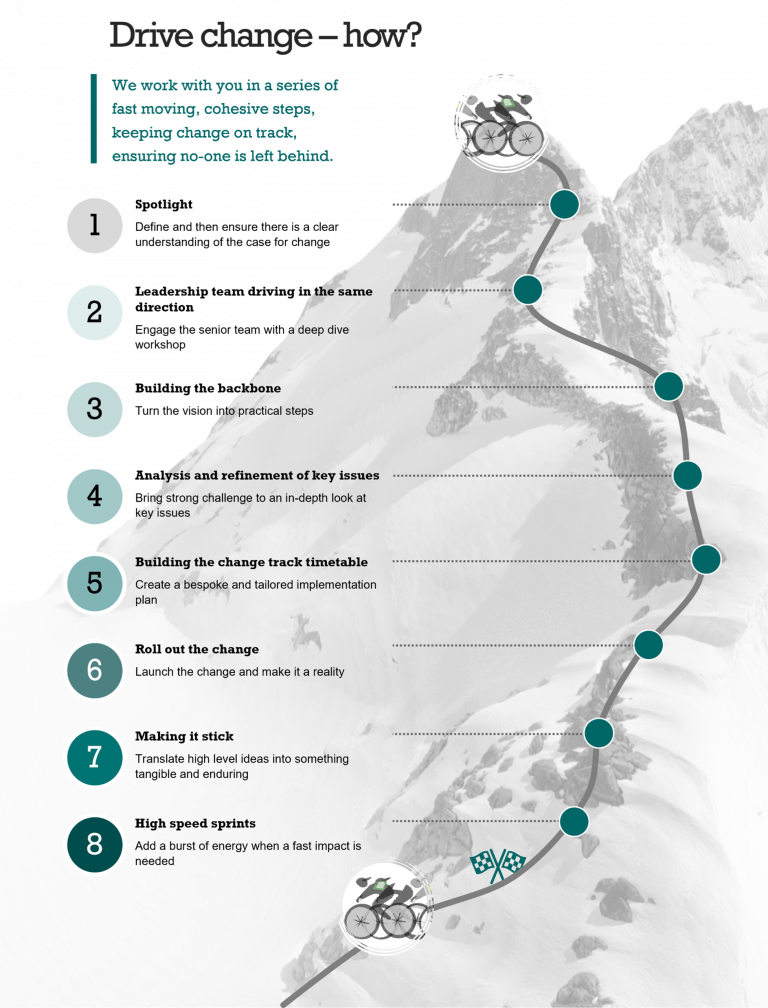
Winning Hearts And Minds: Strategies For Getting Buy-In For Change
Navigating the complex waters of change management is a crucial skill in today’s ever-evolving business landscape.
In the dynamic world of business, change isn’t just inevitable—it’s essential. However, managing this change effectively can be a significant challenge, especially if you don’t have buy-in for change. Drawing from our extensive experience in guiding businesses through transformation, we’ve crafted this article to address two critical aspects of change management.
- The reasons behind common resistance to change.
- Our three-step strategy to secure buy-in for change – a crucial component for successful implementation.
Our goal is to provide insights that pave the way for smoother transitions and more effective change management.
Why do people resist change?
So why do people resist change? In our experience it’s a combination of all the things you’d expect: fear of the unknown, discomfort about loss of control, mistrust in management, a fear of loss of job security and sometimes just plain inertia about doing something differently.
Many of those are standard human reactions to change of any kind, and recognising this is a normal response is a helpful starting point. In some ways you can’t hope to avoid these responses, what you can do is to help people through them and move beyond to a place where employees trust you to lead them through the change and to a brighter, better future.
Top reasons for resisting change:
- Fear of the unknown: The uncertainty surrounding what lies ahead can generate anxiety and hinder the acceptance of change. Individuals may feel uneasy about unfamiliar territory, and uncertain about their roles, responsibilities, and the potential implications for job security.
- Loss of control: Change often disrupts established routines and power structures, which can create a perception of loss of control. Employees who have been accustomed to certain work routines and established power dynamics may feel a sense of unease when those structures are disrupted. We find with many of our clients, that their employees feel like change is “being done to them.” This contributes to that loss of control and resistance that they feel.
- Mistrust in management: A lack of trust in leadership can also fuel resistance to change. For example, if employees are not confident in the capabilities and intentions of their leaders, they are likely to resist the changes those leaders propose. A study from the London School of Economics highlights this. They found that when a UK financial institution with a history of unpopular decisions introduced a new strategy, there was a predisposed mistrust in leadership which led to resistance to that change. Employees doubted the strategy’s viability and the leadership’s motives.
- Misalignment with company culture: While changing processes and structures is important, aligning the culture at the heart of the organisation is crucial to making real change happen and ensuring it sticks. After all, it’s your employees’ everyday habits and behaviours that will be upholding these new changes.
How to get buy-in for change
1. Clear Communication: Early, often and authentic messaging
Clear and transparent communication is a cornerstone of gaining buy-in for change. When we work with organisations to gain buy-in for change, we emphasise authentic, two-way engagement from the start of the change process. It’s impossible to over-communicate when it comes to change – you might feel like you’re repeating yourself, but that’s great – a consistent message makes sure people have really heard it. The advertising ‘rule of seven’ is a good rule of thumb here: each individual needs to hear your message 7 times before they are likely to have fully absorbed it. And don’t worry about holding off communicating until you know exactly where you’re going, you’ve perfectly polished the new brand slides or you’ve got all the data in from the surveys – it actually strengthens the level of trust if you prove that you’re willing to communicate early and often. Aiming for maximum transparency is key: not waiting until things have gone through the board before the employees hear about it.
By communicating changes clearly and transparently, and fostering a sense of ownership among those affected, you can secure buy-in and ensure a smooth transition.
2. Involvement and Participation: Engage your people
We believe that employee involvement in the change process is key to reducing resistance and increasing buy-in.
This goes beyond mere communication; it’s about involving people in shaping the direction the programme takes. This approach helps to ensure that the change doesn’t feel like it’s being ‘done to’ an organisation, but ‘done by’. This is particularly important if you’ve involved external consultants: it can become too easy for people to dismiss a consultant-led change programme as not understanding how the organisation really works, or invokes people just ‘waiting it out’ and waiting for the consultants to move on before reverting back to how it was before. Making sure everyone understands the reasons for the change and is committed to it is critical, and giving a wide set of stakeholders from across the organisation a voice in the process is very important.
By involving employees in the planning and implementation stages, and aligning the change with the organisation’s culture, we can facilitate a smooth transition and gain widespread buy-in for the change.
3. Support and Training: Holding up the map through transition
The final step in getting buy-in for change is providing the necessary resources and training to equip your employees with the skills needed to adapt to new systems and processes. Why? Because your employees need to feel confident and competent with the new way of working. If they don’t, they are far more likely to refer back to the way things are usually done as that’s the path of least resistance.
That’s why our focus is on what people do, why they do it, and the results they achieve, and making sure everyone knows how their piece contributes to the overall picture. Building a detailed view of how each department, and even each role, will play into the new ways of working is the best first step. Then you need to build that information into ‘playbooks’ that lay out how things will work in the new ways of working. Helping people to step through those playbooks in safe training settings, then supporting them as they undertake them in the real world, is a delicate balance but a really important step.
Support and training aren’t just needed to facilitate transitions, but to gain long-term buy-in for change. So make sure you provide comprehensive training and support at this stage.
Get your people onboard
Navigating the complex waters of change management is a crucial skill in today’s ever-evolving business landscape. First, you need to recognise the roots of resistance—be it fear of the unknown, loss of control, or mistrust in leadership. Once you’ve done this, you can then craft strategies to secure buy-in for change, which hinge on clear communication, fostering involvement, and offering robust support and training.
If you do this right, you will find that you won’t only get buy-in from your people, but they will actively drive transformation in your organisation.
Caroline Gowing
Email: carolinegowing@jaconsulting.co.uk
LinkedIn: www.linkedin.com/in/carolinegowinggreenslade
About Caroline Gowing – Caroline is an expert sustainability and change management consultant delivering successful change across Defence, wider corporate business, and the charity sector for the past twenty years.
A highly competent strategy and change management facilitator Caroline is able to work with an individual or group to draw out their understanding of a problem and solution and then take this forward in a way that can be easily understood, persuasively communicated and attractively presented.
Ready to make lasting change?
At JA Consulting, we’re not just about change—we’re about transformation. We understand the barriers that stand in the way of change that should happen but somehow doesn’t. And we help you implement changes that streamline your operations to the point where you’ll wonder how you ever managed any other way.
If you’re aiming to construct a resilient business strategy where change is a common denominator, we’re here to provide the blueprints and the plan to not only implement change but to sustain it in the long run. Let’s embark on this transformative journey together.
Why wait? Reach out to us today, and we can show you how to deliver lasting change that sticks.

_____
And a final thought
At JA Consulting we help drive sustainable change; to work with you to take theory and put it into practice. With the right support and guidance, change can become a seamless and straightforward process that yields long-term results.
Want to make change happen for you? Our team is waiting and ready to help.

